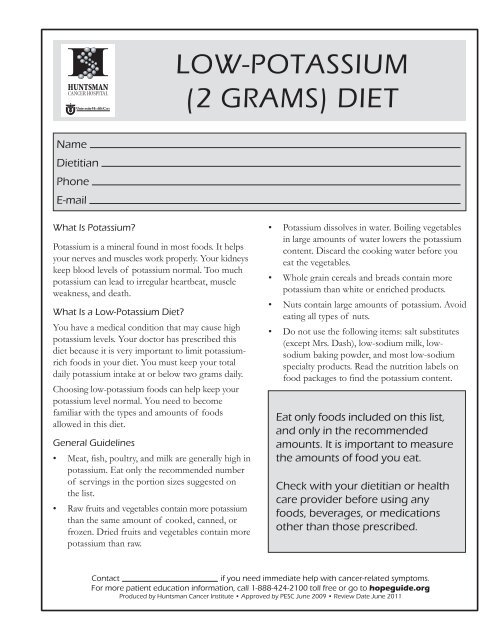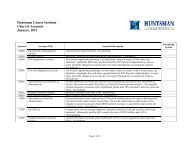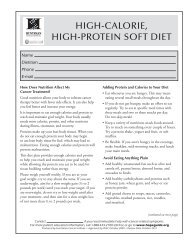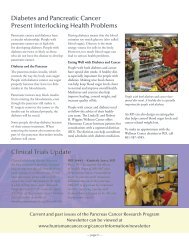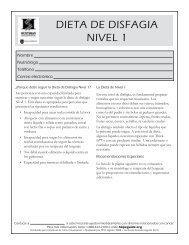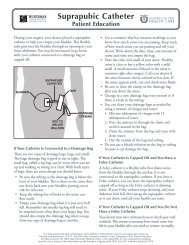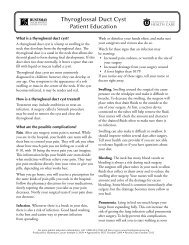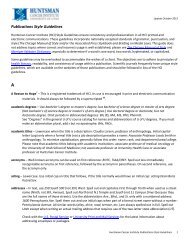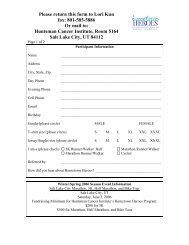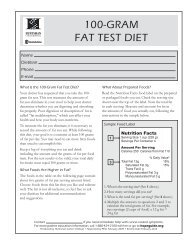Low-Potassium (2 Grams) Diet
Low-Potassium (2 Grams) Diet
Low-Potassium (2 Grams) Diet
- No tags were found...
You also want an ePaper? Increase the reach of your titles
YUMPU automatically turns print PDFs into web optimized ePapers that Google loves.
<strong>Low</strong>-<strong>Potassium</strong>(2 <strong>Grams</strong>) <strong>Diet</strong>Name<strong>Diet</strong>itianPhoneE-mailWhat Is <strong>Potassium</strong>?<strong>Potassium</strong> is a mineral found in most foods. It helpsyour nerves and muscles work properly. Your kidneyskeep blood levels of potassium normal. Too muchpotassium can lead to irregular heartbeat, muscleweakness, and death.What Is a <strong>Low</strong>-<strong>Potassium</strong> <strong>Diet</strong>?You have a medical condition that may cause highpotassium levels. Your doctor has prescribed thisdiet because it is very important to limit potassiumrichfoods in your diet. You must keep your totaldaily potassium intake at or below two grams daily.Choosing low-potassium foods can help keep yourpotassium level normal. You need to becomefamiliar with the types and amounts of foodsallowed in this diet.General Guidelines• Meat, fish, poultry, and milk are generally high inpotassium. Eat only the recommended numberof servings in the portion sizes suggested onthe list.• Raw fruits and vegetables contain more potassiumthan the same amount of cooked, canned, orfrozen. Dried fruits and vegetables contain morepotassium than raw.• <strong>Potassium</strong> dissolves in water. Boiling vegetablesin large amounts of water lowers the potassiumcontent. Discard the cooking water before youeat the vegetables.• Whole grain cereals and breads contain morepotassium than white or enriched products.• Nuts contain large amounts of potassium. Avoideating all types of nuts.• Do not use the following items: salt substitutes(except Mrs. Dash), low-sodium milk, lowsodiumbaking powder, and most low-sodiumspecialty products. Read the nutrition labels onfood packages to find the potassium content.Eat only foods included on this list,and only in the recommendedamounts. It is important to measurethe amounts of food you eat.Check with your dietitian or healthcare provider before using anyfoods, beverages, or medicationsother than those prescribed.Contactif you need immediate help with cancer-related symptoms.For more patient education information, call 1-888-424-2100 toll free or go to hopeguide.orgProduced by Huntsman Cancer Institute • Approved by PESC June 2009 • Review Date June 2011
Food Group Allowed AvoidMilk and dairy productsOne serving equals185 mg potassiumOne serving equals:½ cup milk (skim, 2%, or whole)¼ cup ice creamIce creamSkim milk2% milkWhole milkButtermilkChocolate milkEggnogEvaporated milkHot cocoa<strong>Low</strong>-sodium milkMalted milkMilkshakesSoy milkYogurt (plain or fruited)Meats and proteinsOne serving equals100 mg potassiumOne serving equals:1 ounce cooked meat¼ cup tuna¼ cup cottage cheese1 egg1 thin slice meat1 thin slice cheeseBaconBeefCheeseChickenEggFishHamLuncheon meatsPeanut butterPoultryPorkSausageTurkeyBeans, dried or canned (for example,kidney, pinto, black, garbanzo)MisoNutsTofu2(continued on next page)
Food Group Allowed AvoidFruitsOne serving equals70 to 150 mg potassiumOne serving equals:½ cup fruit pieces1 small whole fruit½ cup fruit juiceDesserts<strong>Potassium</strong> content variesOne serving equals:2-inch square cake⅛ pie½ cup sherbet2 small cookiesApple (fresh or cooked)Apple juiceApplesauceBlackberryBlueberryCherryCranberry (sauce or juice)GrapeGrape juice (frozen)LemonLimeMandarin orange (canned in syrup)Peach (canned in syrup)Peach nectarPear (canned)PineapplePlumRaspberryRhubarbStrawberryTangerineWatermelonCandy (hard)Cake (angel food)Cookies (sugar, sugar wafer,or shortbread)Fruit iceFruit pie (if fruit in filling is on“Allowed” list)Jell-ORice Krispies TreatSherbetApricotBananaCantaloupeCasaba melonDried fruitsHoneydewKiwiGrapefruitGrapefruit juiceGrape juice (bottled)MangoNectarineOrangeOrange juicePeach (fresh, frozen, or cannedin juice)Pear (fresh or frozen)PrunePrune juicePumpkinDesserts containing dried fruit,nuts, or chocolate (unlessapproved by dietitian)Ice cream (unless made withallotted milk servings)Pudding (unless made withallowed milk servings)4
Food Group Allowed AvoidFats and oilsOne serving equals1 to 10 mg potassiumOne serving equals:1 teaspoon margarine, butter orvegetable oil1 tablespoon mayonnaise1 tablespoon regularsalad dressing2 tablespoons gravy2 tablespoons sour creamBeveragesOne serving equals 20 mgpotassium, except coffee andblack tea with 80-100 mg per cupLimit coffee and black tea tomaximum of 1½ cups per dayOne serving equals:1 cup of liquidMiscellaneousOne teaspoon table salt containsabout 2400 mg sodiumButterCooking oilCreamCream cheeseGravyMargarineMayonnaiseNondairy creamerNondairy whipped toppingSalad dressing (if less than 25 mgpotassium per serving)Sour creamWhipped creamCoffeeKool-AidLemonadeLimeadeSoft drinksTea, black (within limit set at left)Tea (green or herbal)Herbs and spicesHorseradishKetchupLemon juiceLime juiceMrs. DashMustardPepperPicklesPickle relishSaltSugar (white)Vinegar (balsamic, cider, or herbal)Salad dressing (if more than25 mg potassium per serving)AmarettoFlavored instant coffeesSpecialty coffees such ascappucino, latte, and mochaMolassesSugar (brown)5


